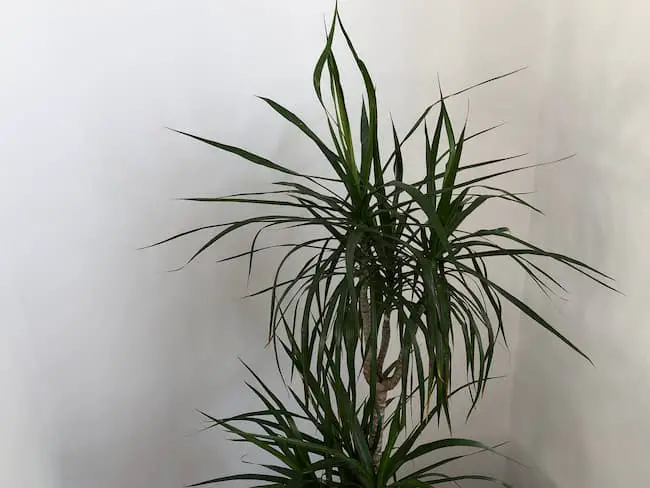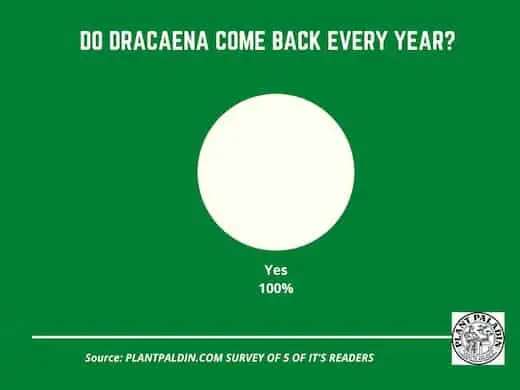This website is supported by its readers. If you click one of my links I may earn a commission. I am also a participant in the Amazon affiliates program and I will also earn a commission from qualified purchases.

Are you tired of annual plants that only last a season and then die off, leaving bare patches in your garden or empty spaces on your windowsill? If so, consider adding Dracaena to your plant collection.
These vibrant and hardy houseplants are known for their colorful leaves and easy maintenance, but one question that often comes up is, does Dracaena come back every year?
Dracaena plants are perennial, meaning they come back year after year, often in the same pot or container. They prefer warm climates, so if you live in a temperate zone, you may need to bring your Dracaena indoors during the colder months.
In this post, we’ll delve into the characteristics and care requirements of Dracaena and provide tips for ensuring that these beautiful plants continue to flourish in your home or garden for years to come. Get ready to add long-lasting color and life to your space with this plant!
Just a quick heads up, over the past three years of running Plantpaladin, hundreds of people have asked for product recommendations. As such, You can find my favorite indoor bonsai tree here (link takes you to Bonsaiboy), my favorite outdoor bonsai tree (link takes you to Bonsaiboy), or have a look at all the products I recommend here.
Do Dracaena Come Back Every Year?
As mentioned before, Dracaena are perennial plants, which means they can regrow and thrive yearly with proper care. However, it’s important to note that not all dracaena species behave similarly.
Some types of Dracaena, such as Dracaena Fragrans and Dracaena Sanderiana, are known for their ability to survive for multiple years and even decades with proper care.
Other species, such as Dracaena marginata and Dracaena Deremensis, may have shorter lifespans and may not last as long.
So, what does proper care for Dracaena look like? These plants are relatively low maintenance and can thrive in various indoor and outdoor environments.
They prefer bright, indirect light and well-draining soil.
Dragon plants should be watered regularly but not to the point of overwatering.
It’s also important to fertilize regularly to ensure they have the nutrients they need to grow and flourish.
In addition to providing proper care, it’s essential to watch out for common pests and diseases that can affect Dracaena. These include aphids, mealybugs, and root rot, all of which can be easily treated with suitable precautions and treatments.
By paying attention to the care and health of your dragon plant, you can help ensure that they continue to come back and thrive.
To summarize:
- All species of Dracaena plants are perennial and come back every year under proper care and maintenance.
- Ensure that your Dragon plant continues to come back every year, provide sufficient light and fertilizer, and avoid overwatering.
- Providing excess fertilizer can also prevent your plant from coming back
- Stem rot, lack of growth, and holes in the leaves are significant signs that suggest your Dracaena plant is not healthy and may not come back next year.
What Prevents Dracaena From Coming Back?
Several factors can prevent Dracaena from coming back year after year. The most common cause of death for these plants is improper care, such as incorrect watering, fertilization, or lighting.
Dragon plants are sensitive to fluctuations in temperature and humidity and can become stressed or sick if they are not provided with a consistent and suitable environment. Pests and diseases can also harm Dracaena and prevent them from returning the following year.
What Species of Dracaena Come Back Every Year?
Some of the most common dracaena species that are known to come back every year include Dracaena Fragrans, Dracaena Sanderiana, Dracaena marginata, and Dracaena Deremensis.
These plants are known for their ability to withstand a wide range of growing conditions and thrive for multiple years with the proper care.
What Species of Dracaena Don’t Come Back Every Year?
There are no known Dracaena species that do not come back every year. However, as mentioned earlier, some species may have shorter lifespans and may only last for a short time. It’s essential to research the specific care requirements of the dracaena species you are growing to ensure they have the best chance of returning year after year.
Dracaena species | Ability to come back every year |
Dracaena fragrans | Yes |
Dracaena sanderiana | Yes |
Dracaena Hawaiian Sunshine | No |
Dracaena marginata | Yes |
Dracaena deremensis | Yes |
Dracaena Limelight | No |
How To Ensure Your Dracaena Comes Back?
To ensure that your Dracaena returns, it’s essential to provide proper care and a suitable growing environment.
Here are some tips for ensuring the success of your plant:
- Provide bright, indirect light: Dragon plants prefer bright, indirect light and will thrive in a location with access to natural light but not direct sunlight.
- Use well-draining soil: Overwatering can be a significant problem for Dracaena, so it’s essential to use a well-draining soil mix and avoid letting the plant sit in standing water.
- Water regularly but not overwatering: To keep the soil moist, Dracaena should be watered regularly. Allow the soil to dry slightly between waterings. Watering, however, should not reach the point of overwatering.
- Fertilize regularly: Dracaena benefit from regular fertilization to give them the nutrients they need to grow and thrive. Use a balanced fertilizer according to the manufacturer’s instructions.
- Keep an eye out for pests and diseases: Common pests and diseases that can affect Dracaena include aphids, mealybugs, and root rot. Be on the lookout for these issues and take steps to treat them if they arise.
These tips can help ensure that your Dracaena continues to come back every year.
Signs That Your Dracaena Will Not Come Back?
A few signs may indicate that your Dracaena will not return the following year. These include yellowing or wilting leaves, dry or brittle stems, and a lack of new growth.
Here are the signs that you should look out for:
Brown or Yellowing Leaves.
One of the first signs that your Dracaena may not come back is if you notice brown or yellowing leaves. This can be a sign of root rot or other types of plant disease, which can be difficult for a dracaena to recover from.
Dry, Crispy Leaves
Another sign that your Dracaena may not return is if you notice dry, crispy leaves. This can be a sign of over-watering or under-watering, which can be detrimental to your plant’s health.
Lack of New Growth
If your Dracaena is not producing new growth, this can be a sign that it is struggling and may not come back. Dracaenas should produce new growth regularly, so if you notice that your plant is not doing so, it may be in trouble.
Signs of Pests
If you notice pests, such as holes in the leaves or sticky residue on the plant, this can signify that your Dracaena is unhealthy and may not come back. Pests can cause severe damage to plants and can be difficult to eradicate once they have infested a plant.
Some animals, like rabbits and deer, can also eat Dracaena.
So please be careful.
Stem Rot
If you notice that the stems of your Dracaena are rotting or becoming discolored, this can signify that the plant will not recover.
Stem rot is a severe condition that can affect your plant’s health and may require professional treatment. Ever wondered why your Draceana has brown spots?
Overall, it is essential to pay attention to your Dracaena’s health and appearance and address any issues as soon as they arise.
By taking good care of your plant and addressing any issues promptly, you can help ensure that your Dracaena remains healthy and continues to thrive.
What Time Of Year Do Dracaena Reappear?
Dracaena generally do not go through a dormant period, so they do not disappear and reappear at a specific time of year as some other plants do.
Instead, they continue to grow and produce new leaves throughout the year as long as they are provided with proper care and a suitable environment.
Will Dracaena Come Back If You Cut Its Leaves?
Dracaena can regrow new leaves if their old leaves are damaged or cut off. However, it’s essential to be careful when pruning Dracaena. Ensure you only remove a little of the plant at a time. Over-pruning can stress the plant and prevent it from returning as robustly as it would have otherwise.
Do Dracaena Lose Leaves In Winter?
Dracaena is not known to lose its leaves in winter. These plants are native to tropical regions and do not experience significant changes in temperature or light levels throughout the year.
However, Dragon plant can lose leaves due to stress or improper care, such as incorrect watering or lighting.
Can Dracaena Survive Winter?
Dracaena can survive winter if they are grown indoors or in a protected outdoor location where they are protected from frigid temperatures. These plants are not tolerant of freezing temperatures and will die if exposed to freezing conditions for an extended period.
Suppose you are growing Dragon plants outdoors in a region with cold winters. Providing them with adequate protection is essential, such as moving them to a sheltered location or covering them with a frost blanket.
Dracaena grown indoors can also be affected by cold drafts or fluctuating temperatures. Keeping them in a consistent and suitable environment is essential to ensure their survival through the winter months.
Overall, Dragon plants are hardy and long-lasting plants that can thrive for multiple years with proper care. With a little effort and attention, you can enjoy these beautiful plants’ vibrant and colorful leaves for many seasons.
Related Questions
Can Dracaena Live Outside In Winter?
Dracaenas are tropical plants and are generally not tolerant of cold temperatures. As a result, they should be kept in winter in most climates.
If you live in a warm, frost-free climate, you may be able to keep your Dragon plant outside during the winter, but it’s crucial to provide shelter to protect it from extreme temperatures and drying winds.
In most cases, it’s best to bring your Dracaena indoors during the winter to ensure its survival. Find out whether it’s a good idea to leave your Dracaena outside.
How Long Does a Dracaena Live?
Wild dracena trees can live in the wild for 100 to 1000 years in the right conditions. Most dracena trees kept indoors will live for 50 to 60 years. It is not uncommon for well-cared-for dracena grown indoors to outlive their owners.
The lifespan of a dragon plant can vary greatly depending on the specific species and the care it receives. Some dracaena species can live for many years, while others have shorter lifespans. In general, dracaenas are relatively easy to care for and can be long-lived plants if provided with the proper care.
Will Dracaena Come Back After a Freeze?
Dracaena plants are generally quite hardy and can tolerate a wide range of temperatures, including some frost. However, if the plant has been exposed to freezing temperatures for an extended period, it may suffer damage or even die.
If the plant has only been exposed to a short period of freezing temperatures, it may recover if not too severely damaged.
As a good rule of thumb, if you keep your dragon plant outdoors and the weather is predicted to be particularly cold, cover it with a light tarp.
This should protect the tree from harsher winter conditions.
Do Dracaena Come Back Every Year? Survey results
So finally, I wanted to give more than just my experience in growing dracena but wanted to give a more comprehensive sample size on if dracena comes back every year.
As such, I got in touch with my local botanical gardens and quickly surveyed plant paladin readers to verify my findings.
To summarize, you can see the results below:

Final Thoughts
If you want to add some life to your home, consider bringing in a dracaena plant!
These popular houseplants are known for their stunning, colorful leaves and uncomplicated care requirements. Plus, they can come back year after year with the right conditions.
However, it’s worth noting that not all dragon plant species are alike.
Some may have shorter lifespans than others, so it’s essential to do your research before bringing one home.
To help your Dragon plant thrive, provide it with bright, indirect light, well-draining soil, regular watering, and consistent temperatures. With these simple steps, you’ll be able to enjoy the beauty of your Dracaena every single year.
My top picks for the gear you will need!
So like I mentioned earlier, over the past three years of running PlantPaladin, hundreds of people have asked me for my recommendations on the best bonsai gear on the market.
Having spent thousands of dollars on bonsai items these past few years and tested at least 100 bonsai-specific products, I’ve listed my favorite products below – All of which I highly recommend and think you can get great value.
They can purchase directly by clicking the link to take them to Amazon.
Bonsai Tool Set: One of the significant challenges I’ve had is finding a toolset that was not only durable but didn’t break the bank. SOLIGT has recently developed a fantastic bonsai tool set that covers all the tools you need to trim, prune, and repot your trees. – You can grab it here.
Complete Bonsai Set: Many of you will want to grow your bonsai trees entirely from scratch, but finding the varicose seeds, pots, and other items in one place can be challenging. Leaves and Sole then have created a complete bonsai set that I’ve personally used that ticks all the boxes. You can grab it here.
Bonsai wire: The number of times I’ve run out of wire for my bonsai or purchased cheap bonsai wire that doesn’t do the job is embarrassing for me to admit. After a lot of trial and error, I found that using Hotop’s aluminum bonsai wire is one of the best options on the market. This can easily be used for both indoor and outdoor bonsai. You can grab it here.
This post was written by Fehed Nicass, who has been passionate about bonsai for over three years.

